Accounting and taxation aren’t just back-office formalities — they’re essential tools for strategic business management. And when a country’s tax policy shifts, entrepreneurs need to adapt quickly and smartly. One of the most significant upcoming changes in Estonia is the VAT rate increase and the cancellation of a proposed “defense tax.” Here’s what’s changing, what’s not, and how to prepare.
🔺 VAT Increase to 24% from July 1, 2025
Under the amended Value-Added Tax Act (§ 15-2 Käibemaksuseadus), Estonia’s standard VAT rate will increase from 22% to 24% starting July 1, 2025. This affects all goods and services taxed at the standard rate — in short, almost everything will get 2% more expensive overnight.
📌 Key Detail: The higher rate will remain in effect until December 31, 2028. From January 1, 2029, the rate is set to return to 22%.
🔍 Example:
If you sell a product for €100 (excluding VAT), then from July 1, 2025, the VAT on your invoice will be €24 instead of €22. The total invoice amount will rise to €124.
What Businesses Should Do Now:
- ✅ Review and update pricing lists to reflect the new rate.
- ✅ Adjust ERP systems, POS terminals, and e-commerce platforms accordingly.
- ✅ Notify customers and partners if your contracts specify VAT-inclusive prices.
- ✅ Train your sales and accounting teams to handle the updated tax rate seamlessly.
❌ 2% Corporate “Defense Tax” Has Been Scrapped
Back in December 2024, Estonia passed the so-called “Security Tax” (Law 512 SE), which included a planned 2% corporate tax on net profit starting in 2026 — essentially a local version of a corporate income tax.
However, in April 2025, the newly formed coalition government (Reformierakond and Eesti 200) decided to scrap this part of the law. The official repeal is expected to be passed by parliament by the end of 2025
📌 Bottom Line: There will be no additional corporate tax in 2026 — and no increase in personal income tax, either.
💡 Why This Matters:
- More clarity and stability for long-term tax planning.
- No need to restructure accounting practices to accommodate a new tax.
- Estimated national savings of up to €100 million annually.
💼 What This Means for Your Business
The simultaneous removal of the corporate tax and increase in VAT creates a mixed picture:
- 📉 Your profit-related costs stay flat — you can continue dividend planning as usual.
- 📈 The higher VAT increases pressure on B2C businesses and companies with high domestic consumption.

